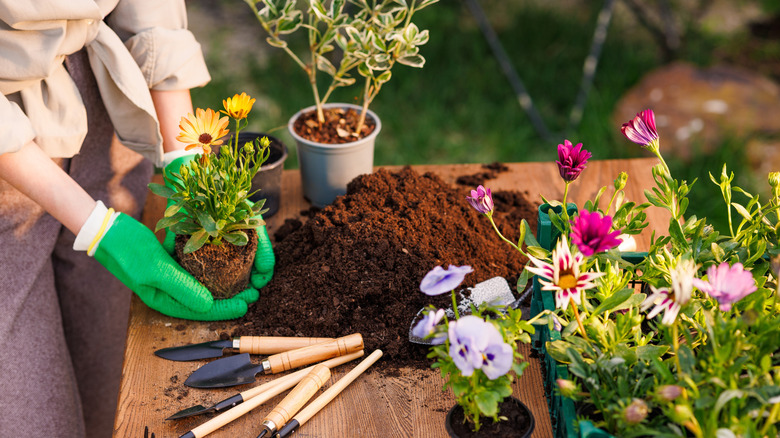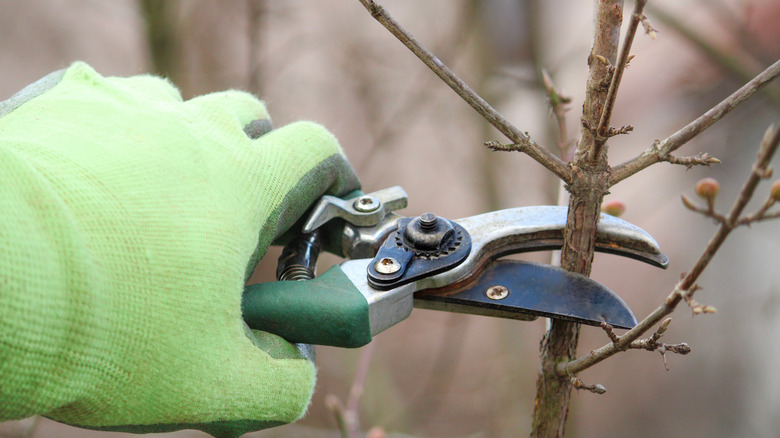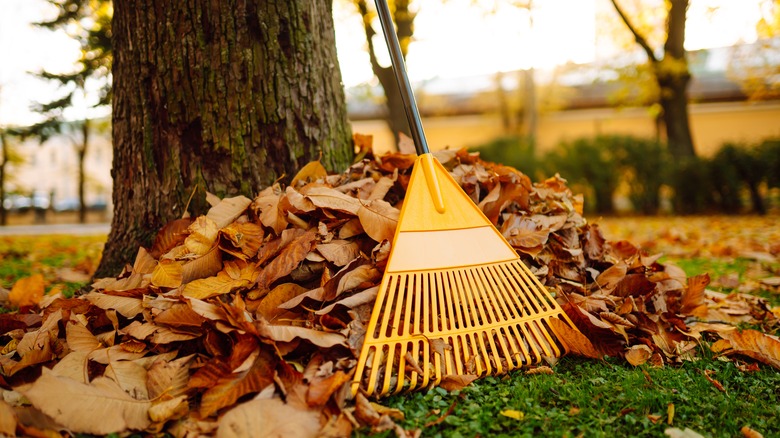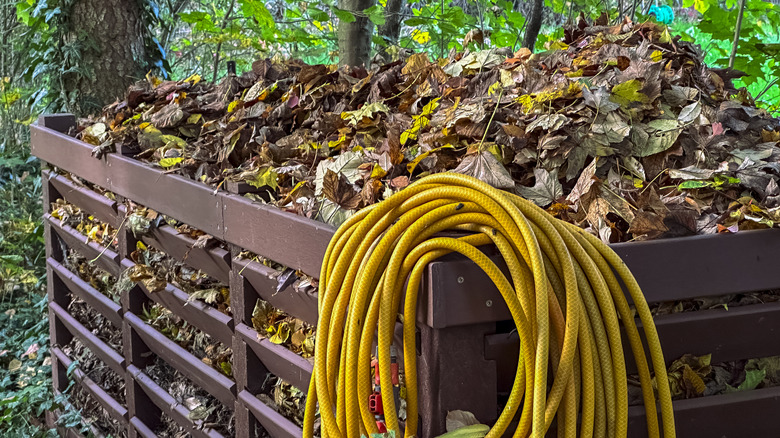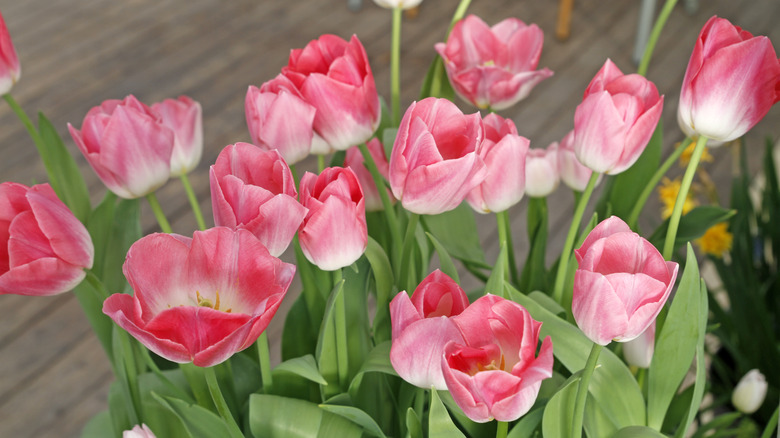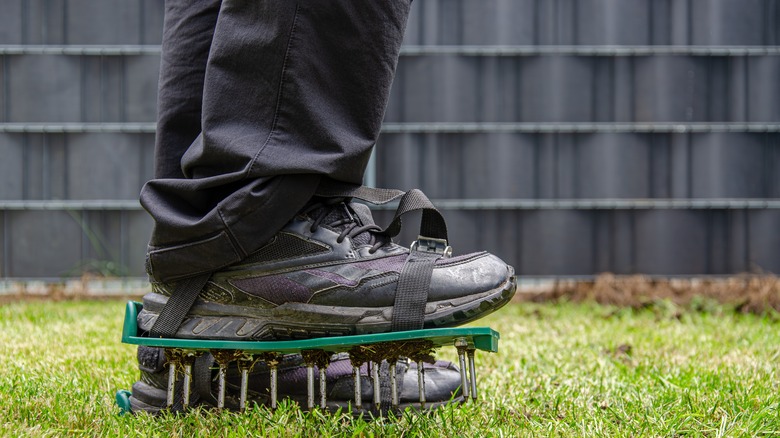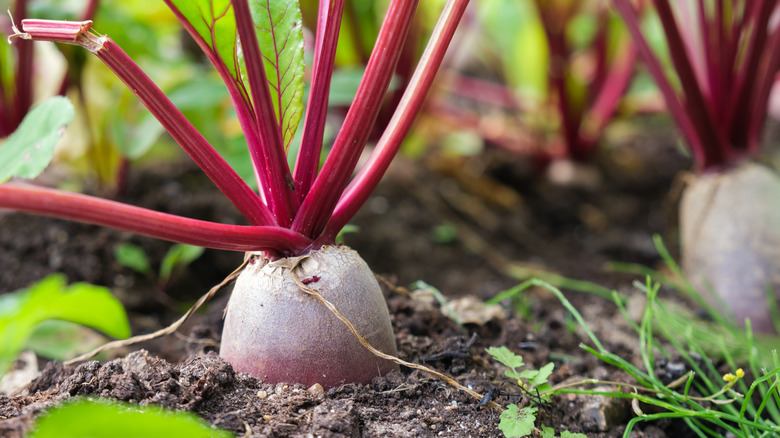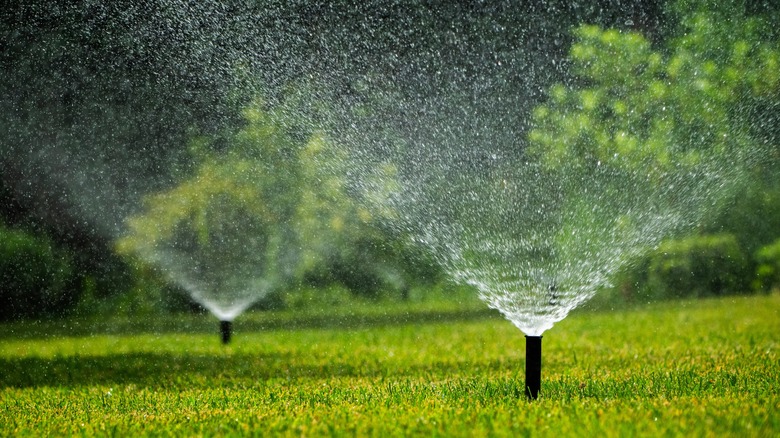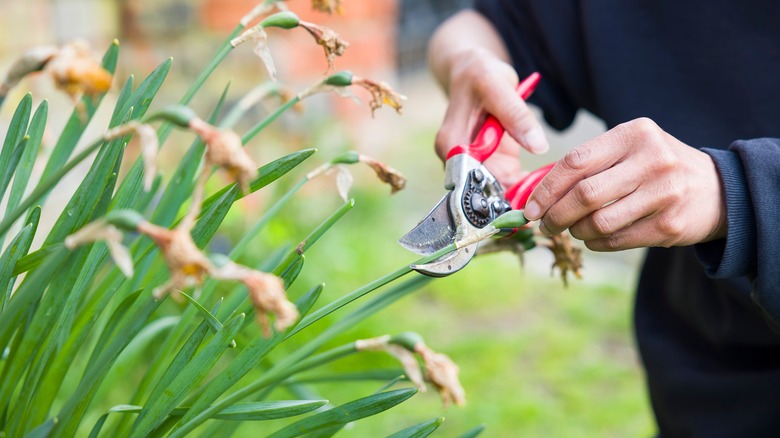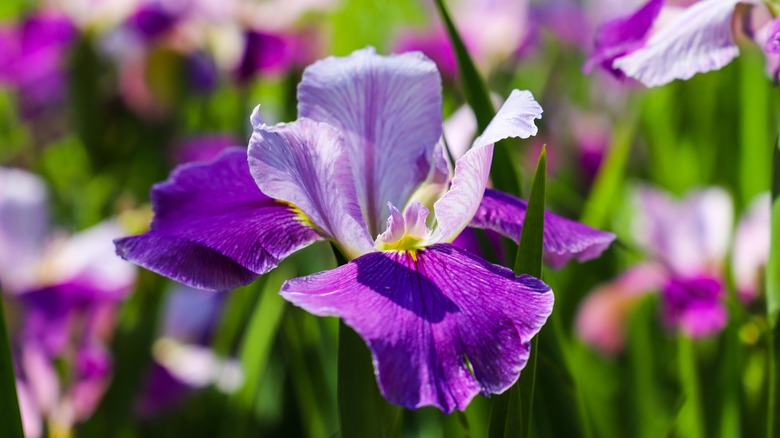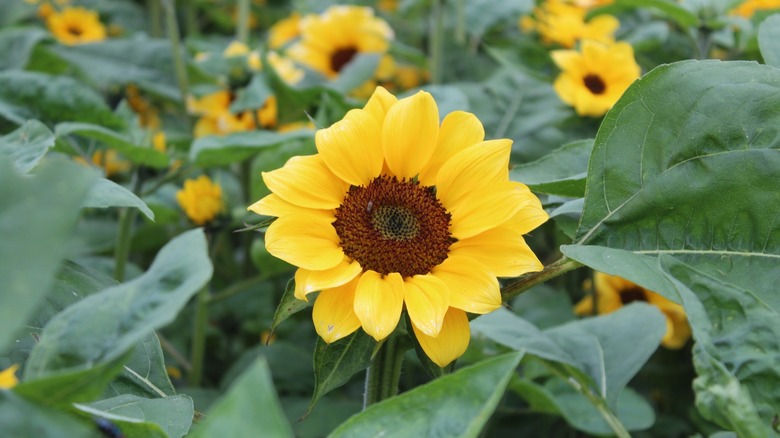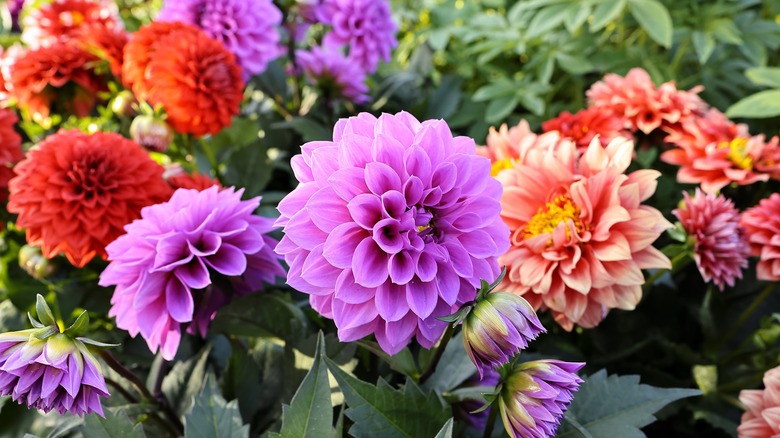The Ultimate Fall To-Do List For The Garden Of Your Dreams
We may receive a commission on purchases made from links.
You might not think of the fall as the perfect time to grow the garden of your dreams. But there are actually plenty of things you can do to prepare for next spring and summer as the nights get colder. In fact, each month of the year comes with a unique to-do list to make sure your outdoor space is at its best.
Fall is a season of preparation. You do things like tucking plants in for the winter, protecting them from the elements, and setting the stage for next year's blooms. It's also the ideal moment to take stock of your garden's successes and challenges, make adjustments, and give your soil, trees, and flower beds the care they need to thrive. So, once you've finished the gardening tasks to do in August to prepare for the end of the year, this is what you need to check off your list in September and beyond to keep things healthy and thriving, year after year.
Prune dead or damaged branches
Fall is the perfect time to remove any dead or broken branches from the trees in your garden. Doing so before the cold weather of winter sets in can help prevent storm damage. The heavy winds and snow of a winter storm can snap vulnerable limbs, causing harm to both the plant and your property. While it might be tempting to give your trees and shrubs a full trim, avoid general pruning in the fall. Instead, the spring is the better season for that, giving fresh cuts time to heal before new growth begins. If you do this now, the exposed bits might be too cold and cause damage. Pruning in the fall is just about assessing risks of things that might be hazardous during the upcoming winter.
When pruning, look for branches that hang over your house as well as frequently used pathways. Different spots are likely to need different-sized shears to get the job done completely, so consider a set like the Centurion 3-Piece Lopper, Hedge Shear & Pruner Combo, which gives you more options. Safety-wise, always wear protective gloves and safety goggles, especially when tackling larger limbs. (For tall or hard-to-reach branches, consider hiring a certified arborist rather than attempting the job yourself.) When you're done, disinfect your tools to prevent the spread of plant diseases. Soapy water and a clean rag will typically do the trick.
Rake up most of the leaves (and keep some for later use!)
As beautiful as a blanket of autumn leaves looks in your garden, leaving a thick layer of them on your lawn can actually smother the grass, preventing it from growing and causing mold. Raking regularly in the fall helps keep your turf healthy. It makes sure it gets the light and air it needs before falling into a winter dormancy. But don't bag up all that fallen foliage and leave it out for trash collectors. Instead, all those leaves are packed with nutrients that can benefit your garden, so you should plan to keep them around.
When cleaning things up, use a lightweight rake, like the Oliynedy Adjustable Metal Leaf Rake, which comes with an adjustable head, so it can get into lots of tight spots. A leaf blower is another good option. Whatever you use, work on a drier day, as the leaves are easier to handle when they aren't damp and heavy. If you plan to keep the leaves to make mulch, gather a portion of them into a bag or barrel made of chicken wire. When wet, and left to break down until the next fall, you'll have a rich, nutrient-dense soil that you can use as potting mix, or mulch for your flowerbeds. Just be sure to avoid the outdoor compost bin mistakes that are attracting pests to your yard, like adding non-plant-based items or not turning the pile consistently.
Top-dress your beds and borders with compost
Fall is an ideal time to add a nutrient boost to your garden by top-dressing beds and borders with compost. If you have your own compost heap, this is the moment to harvest the fully decomposed material and put it to use. Alternatively, high-quality bagged compost works just as well, like the Michigan Peat Garden Magic Compost and Manure Blend. Adding compost now gives it the whole winter to break down naturally. This allows helpful tiny creatures (like worms!) in the soil to work on it and turn it into stable, healthy dirt. Over time, this makes the soil better by providing more nutrients for your plants, helping them start strong and healthy in the spring.
Spread a layer of compost that's about one-half to an inch thick over the surface of your garden beds and around the base of shrubs and perennials. If your compost is still a little coarse, you can sift out large chunks for faster results and return those to the heap for further decomposition. Fall's cooler, damper conditions make this an easy, low-effort job that quietly pays dividends when the growing season returns.
Plant spring-blooming bulbs
Fall is the perfect time to tuck spring-blooming bulbs like daffodils, tulips, hyacinths, and crocuses into the soil of your garden. Planting before the first frost gives them time to establish stronger root systems during the cool months. By doing this, they are more likely to burst into color as soon as the weather warms. That is, this short window of planting sets the stage for one of the first and most welcome sights of spring: bright, cheerful blooms after a long winter.
Choose a sunny, well-drained spot and plant bulbs at a depth about three times their height. For tulips, daffodils, and hyacinths, you need to plant them with the pointy side of the bulb facing up. This way, the roots can grow deep into the earth without having to loop around first. Remember, space them according to the package instructions to give each bulb room to grow. Mix in a little compost or bulb fertilizer at planting time for extra nourishment. After covering them with soil, water the area well to settle them in. For added impact, plant bulbs in clusters or drifts rather than just in single rows. This creates a more natural, abundant look when they flower instead of looking too planned.
Aerate your lawn
Aerating in early fall helps loosen compacted soil, allowing nutrients to reach grass roots before it gets too cold. This simple step helps to prepare your lawn to withstand the stresses of winter weather. While some people also complete this in late spring, it's best not to overdo it, as over-aerating can damage the turf. The ideal timing also depends on your grass type. That is, cool-season grasses benefit most from early fall aeration, while warm-season grasses should be aerated in late spring or early summer instead. So before you begin, be sure to double-check what type of grass you have.
An aerator is actually one of the essential lawn tools for healthy green grass. However, you might not need to purchase a new tool to do it, depending on the size of your lawn. For small lawns, a manual aerator or garden fork can work well, but for larger areas, renting or hiring a core aerator will save time and energy. Try a manual tool, like the Walensee Lawn Aerator Spike, or the Briliantwerk Lawn Aerator Shoes, that attach to your work boots. You can even just use a hand drill on a small yard, if needed. No matter what tool you use, leave the soil plugs (the bits of earth you dredged up!) on the surface after aerating, as they'll naturally break down and feed the lawn.
Plant vegetables that do better in cool weather
When working in your garden during the fall, you can still enjoy planting and harvesting. This is especially true if you focus on vegetables that tend to grow better in cooler conditions, anyway. These are going to be your root vegetables like beets, carrots, parsnips, radishes, and turnips. Stem crops, like asparagus and white potatoes, can also easily establish themselves for a future harvest if the soil is cool. Finally, leafy greens like cabbage, celery, lettuce, and spinach flourish without the stress of summer heat, and even immature flower crops such as broccoli, cauliflower, and globe artichokes can get a strong start before winter. Planting now means you'll be rewarded with fresh produce into the colder months. And, in some cases, an earlier harvest next spring!
The typical tips for planting a vegetable garden apply during the fall, too. Things like preparing your garden beds by removing summer crop residues and loosening the soil to improve drainage and aeration can go a long way. Plus, following the spacing and depth guidelines for each crop, and watering them consistently to help young plants establish strong roots before frost. However, as cooler nights set in, use row covers or cloches like the CedarCraft Greenhouse Cover to create a slightly warmer microclimate if you feel like things are getting a touch too cold. You can also use mesh bags like this to protect your vegetable garden from pests.
Adjust your watering schedule as the nights begin to get colder
As autumn settles in, your garden's thirst changes. While cooler nights might mean less evaporation, plants still need consistent moisture to head into winter healthy and resilient. That said, adjusting how often you manually water your lawn and the plants in it (or retiming your automatic sprinklers) is essential for fall.
For your lawn, most turfgrasses will need about an inch of water a week. As it gets cooler, it might be less, depending on the conditions. Walk on the grass to see if it stays compacted where you've stepped. If it doesn't and the grass springs back, it's fine. If it stays down and your footprints linger, it's time to add a little water.
For trees and shrubs, before watering, check the soil moisture rather than sticking to a rigid schedule. About once a week, dig a small hole about three to four inches deep under the plant's drip line, or the circle around the farthest reaches of its branches. If it's dry at that depth, it's time to water deeply. If you prefer an instrument to help you, try the XLUX Long Probe Deep Use Soil Moisture Meter. Focus on soaking the root zone rather than giving frequent light sprinkles. This encourages deeper root growth. For bulbs and perennials, water early in the day so foliage dries before nightfall, reducing the risk of any potential fungal issues.
Practice strategic deadheading
As summer fades into fall, a little strategic deadheading can work wonders in keeping your garden vibrant for as long as possible. By removing spent flowers, you prevent the plant from putting energy into seed production and instead direct it toward fresh growth. Many annuals and perennials like hardy geraniums, catmint, and lady's mantle respond by blooming again after being deadheaded, carrying color into the cooler months and giving pollinators one last feast before winter.
But "strategic" is the key word here. Not every plant should be deadheaded. While bellflowers and evening primrose need it, sometimes, letting flowers go to seed is the smarter choice. Self-seeding plants like foxgloves and forget-me-nots will scatter seeds for free plants next year, while seed heads from coneflowers, sunflowers, and ornamental grasses provide valuable winter food for birds! By choosing which plants to deadhead and which to leave, you can enjoy both extended flowering now and a garden that's already working toward its future. Think of it as a seasonal balancing act. Some blooms are cleared away to make space for more, and some are left behind to carry the garden's story into next spring.
Divide and replant perennials
One thing to know about dividing perennials every few years is that it's a simple but powerful way to keep them healthy and your garden looking full. Over time, clumps of plants like hostas, daylilies, and irises can become overcrowded, which weakens the plant and eventually reduces its bloom. Splitting them up not only rejuvenates the parent plant, giving it more room to grow, but also provides you with "free" new plants to fill bare spots or share with friends. Late summer to early fall (when temperatures are cooling but the soil is still warm!) is an ideal time for this task, as it gives the roots time to establish before winter.
Many perennials, such as achillea, coreopsis, echinacea, and monarda, will benefit from division every few years, though not all need it annually. To stay organized, keep a simple garden log noting which plants you've divided and when, so you avoid repeating the process too soon. For best results, water deeply the day before to make lifting and separating easier. Use a spade or garden fork to carefully lift the plant, then split the root ball into smaller sections. Look it over to make sure it's healthy. Replant the divisions promptly, water them in well, and top-dress with compost to help them settle in. When done regularly, this small effort keeps your perennials vigorous and your garden rich with layers of healthy, thriving plants.
Collect seeds from your favorite plants to use next year
As summer winds down, many spring-sown annuals reach maturity and are ready to pass on their legacy in the form of seeds. Flowers like zinnias, sunflowers, coneflowers, and poppies produce seeds by late summer, making this the perfect time to collect and preserve them for next year. You can also save seeds from food, too, like tomatoes, peppers, beans, and peas. Saving your own seeds allows you to continue planting the plants you love, and reduces the cost of purchasing seeds each spring.
To collect seeds effectively, wait until at least early afternoon so any morning dew has evaporated. Gather seed pods or dried flowers and bring them indoors, spreading them on paper towels to ensure they are completely dry. Store the seeds in labeled paper bags with the plant name and date of collection. This allows air to circulate, but also keeps them mostly dry during storage. Pre-labeling your bags beforehand can make the process smoother and prevent mix-ups later. Over time, maintaining a simple system of collection ensures you'll have a ready supply of healthy seeds to start your garden next year, preserving both your favorite blooms and the satisfaction of growing them yourself.
Lift tender bulbs and tubers
Preparing for frost is a key part of a healthy autumn gardening routine, giving tender plants the best chance to survive and thrive. Tender bulbs and tubers, like dahlias, gladiolus, and cannas, require extra care as the first light frost approaches, usually between September and November, depending on your location. If you know which USDA growing zone you live in, and it's a milder one, it may be possible to cut back the tops, leave the plants in the ground, and cover them with a thick layer of mulch for protection. In colder zones, or gardens that are more exposed in general, plants may need to be removed from the ground for overwintering.
If so, carefully dig up the bulbs or tubers just after the first frost. Gently remove the excess soil by hand. Then, allow the cuttings to dry in a cool, airy spot for more than a week. Once completely dry, store them in a cool, dark location, like a basement, greenhouse, or shed. However, it can't ever frost in there, so be mindful of the temperature! Store the flower boxes or paper bags filled with dry peat moss, sand, or sawdust to prevent root rot.
